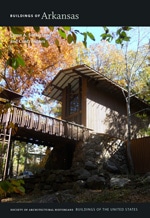In 1909, the Arkansas legislature approved an appropriation to establish a tuberculosis sanatorium. Booneville was chosen as the site after the town donated a thousand acres of land on a hill, which offered optimal fresh air for the patients and was sufficiently isolated to prevent the spread of the disease. The hospital opened in 1910 with a small building housing 64 white patients. (A hospital for nonwhite patients was not opened until 1930 in Alexander, near Little Rock.) The institution eventually expanded to 76 buildings. Among them is the Nyberg Building (named for state senator Leo Nyberg, who advocated for the building and who died of the disease), a five-story hospital built in 1938 with a bed capacity of 500. A separate building of 1948 housed children with the disease. By 1940, the sanatorium was the largest facility of its type in the nation. The complex included dormitories, a chapel, a movie theater, a general store, a post office, a library, and an elementary school. Between 1930 and 1950, the sanatorium had staff of 300 and housed up to 5,000 patients at a time. The institution was self-sustaining with a farm that had cattle, pigs, vegetable gardens, fruit orchards, a dairy, and a cannery. In the 1950s new drugs to treat the disease resulted in a declining number of patients, and the sanatorium closed in 1973. The Booneville Human Development Center now occupies some of the buildings, and in 2010 the Arkansas Tuberculosis Sanatorium Museum opened with exhibits relating the story of the hospital.
You are here
Arkansas Tuberculosis Sanatorium Historic Site
If SAH Archipedia has been useful to you, please consider supporting it.
SAH Archipedia tells the story of the United States through its buildings, landscapes, and cities. This freely available resource empowers the public with authoritative knowledge that deepens their understanding and appreciation of the built environment. But the Society of Architectural Historians, which created SAH Archipedia with University of Virginia Press, needs your support to maintain the high-caliber research, writing, photography, cartography, editing, design, and programming that make SAH Archipedia a trusted online resource available to all who value the history of place, heritage tourism, and learning.


